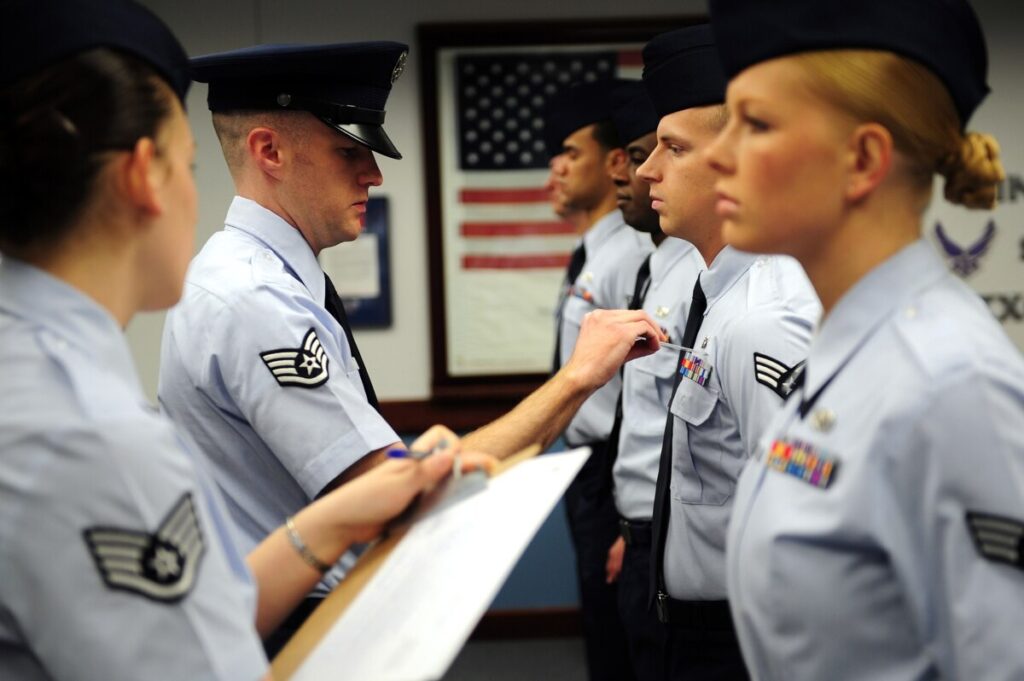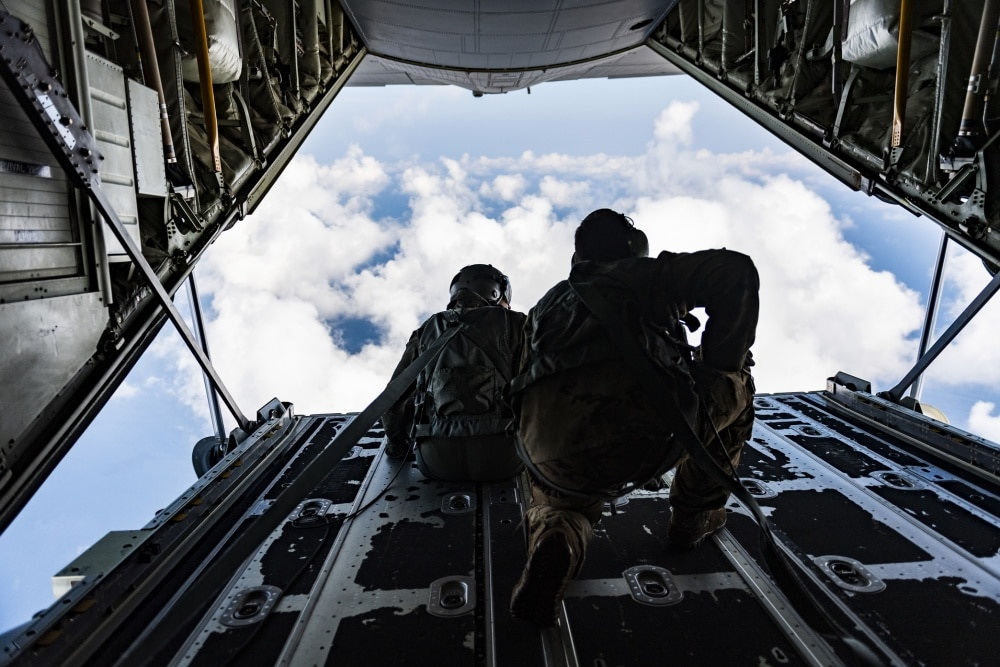Joining the United States Air Force requires comprehensive training to become a proficient Airman. Air Force basic training is considered by some to be the ‘easiest’ of the branches. While it is shorter than the Marine Corps’ and Army’s basic training programs, it is still an exceptional test of a young recruit’s physical and psychological fortitude.
Not everyone can become an Airman. Reports have found that over seven in ten young people are incapable of even becoming a recruit. The Air Force takes its pick of the applicants among the three in ten who are eligible, putting them through 8.5 weeks of training, which, for most of them, is unlike anything they have gone through before. Together We Served is a veteran locator tool that helps American military veterans reconnect with others they met during their military career, whether they shared a duty station, squadron, or basic training. We are providing a rundown of modern Air Force training for veterans to compare to their own experiences.
Air Force Basic Training Timeline
Those who satisfy the Air Force basic training requirements (not obese, no criminal record, and a high school diploma) will converge on San Antonio, Texas, to begin boot camp at Lackland Air Force Base. Lackland has been the basic training center for the Air Force since 1946, before the Air Force was officially established as a distinct branch of the military. The Air Force basic military training (BMT) has changed over the decades to better serve the evolving Air Force’s needs.
At present, the timeline of Air Force boot camp looks like this:
- Zero Week: Trainees are assigned a squadron and flight, shown their Personal Living Area (PLA), and shown the Dining Facility’s ropes (DFAC). They will break in their new boots, undergo drug tests, and male recruits will receive their military haircuts.
- Week One: Trainees receive vaccinations, undergo their first physical fitness test, and are assigned a fitness group. Trainees unable to pass this initial test are put in the remedial group for additional physical training.
- Week Two: Trainees discuss with job counselors the Air Force jobs they are qualified for and available. Counselors will attempt to ensure that everyone gets their first preferences as much as possible.
- Week Three: Trainees receive training with an M-16: safe use and handling, and how to assemble, disassemble, and repair it.
- Week Four: During this time, trainees attend FEST Courses, learning the skills necessary to defeat the BEAST in Week Five. They learn rifle fighting techniques, crawling through a sand course, moving in columns, and using proper hand signaling. They also go through CBRNE training (Chemical, Biological, Radiological, Nuclear, and high-yield Explosives). Trainees learn how to counter terrorism, biological and chemical weapons, and security breaches. They will also undergo limited exposure to CS gas.
- Week Five: This week, trainees face the BEAST: the Basic Expeditionary Airman Skills Training. All of the skills and tactics the trainees have undergone will be tested in combat scenarios and realistic field training exercises. The BEAST lasts five days and puts trainees’ CBRNE skills to the test. Trainees must wear body armor, helmets, two canteens, and carry an M16. They will go through Combat Arms Training and Maintenance (CATM) to fire and qualify using an M16, practicing firing while standing, sitting, kneeling, and prone. Especially talented shooters can receive the Small Arms Expert Ribbon for strong performances here. Most other tasks require teamwork to conquer: a team will fail if a member does not pass through will the rest of their team. On the final day of the week, trainees receive their dog tags.
- Week Six: This week focuses on post-deployment training, though practice drills and dorm inspections still occur. Recruits also learn about Air Force history and heritage. They undertake the final physical training (PT) test: failure at this stage means to transfer into the ‘Get Fit’ flight and extra time to improve fitness scores to the necessary standard. They also take the Air Force End of Course exam and receive their Air Force Specialty Code (AFSC) if they were not previously assigned.
- Week Seven: Trainees undergo a final 1.5-mile run, the Airman’s Run, and are presented with their Airman’s Coin, making them official Airmen. They can see their loved ones, and the next day attends the Graduation Parade, taking their final oath of enlistment. Airmen are afforded more freedom and prepared for their assignments’ hardships before proceeding to their technical training school for their AFSC. The technical training period can be between one month and two years.

Is Air Force Basic Training Hard?
In a word, yes. While some in other branches are entering the Air Force as a ‘soft option,’ there is no such thing as an easy boot camp. Air Force recruits must run 1.5 miles in under 12 minutes (14:20 for women) and do a minimum of 33 pushups and 42 situps (27 and 50 for women). They must be able to assemble and disassemble an M16 and fire it proficiently. They must endure CS gas, triumph over a series of rigorous combat simulation exercises, and learn the basics about a branch of the US military on less than 8 hours sleep a night. Recruits may not use tobacco products or eat outside of designated meal times. They must obey their military training instructor and strictly abide by their training schedule. 8.2% of recruits fail out of basic training. Air Force Basic Training is hard, but it creates warriors and leaders fit to serve in the world’s strongest and most versatile Air Force.
Remember Your Air Force BMT with Together We Served
It’s easy to sign up for an account with the world’s largest veteran locator service, Together We Served. We collect stories from every veteran we can, including Air Force veterans, keeping them immortalized in a massive online repository, a testament to the sacrifices of America’s servicemen and women. You can enter all sorts of information into your service profile: your unit, medal ribbons, campaigns, even your boot camp. Together We Served will help you find others whose profiles match your details so that you can find other service members from your past.

I served as the Training Officer in the 3727th and 3724th Basic Military Training Squadron from July 1970 through June 1974. I only served 4 years, as the Vietnam War was winding down and the Air Force was placing rated pilots in command positions as they returned, hoping to increase their experience in command. Not being rated was a limiting factor for my future in the Air Force in my mind. I was one of about 16 other Training Officers in all of BMT. I had an Education and Training AFSC and had never really worked in that AFSC. I thought I would be a junior Capt. with a limited experience trying to get into a meaningful Air Force assignment. As I look back, I wish I had tried. Instead, I enjoyed 28 years as an Industrial Arts teacher in a public school.
As a young 2nd Lt, only 21 years old,I had the privilege of “supervising” a CMSgt with 22 years of Air Force service. Fortunately, I was smart enough to listen, watch, and learn about what success as a young officer was all about. I had the honor of serving with some of the top NCO’s the USAF had to offer. I think about many of them often as I recall my time in the Air Force.
I was one of 3 officers in the squadron. In 1970 a senior 1st Lt (if there is anything such as a senior 1st Lt…he said with a smile) was often serving as the commander, with automatic promotion to Capt. at 3 years in service. As the Air Force began placing pilots in command positions, they often came in as senior Capt. or just promoted Majors. The administrative officer was a 2nd Lt. The Training Officer came in as a 2nd Lt and supervised all the training operation in the squadron.
The CMSgt I mentioned earlier was the Training Superintendent and the real key to success of the mission.
At the time, BMT was 6 weeks in duration. We paraded twice each week, Tuesday and Friday. Each flight participated near the middle of their training and again in the last week. Each flight was assigned 2 TI’s, with the flight consisting of 50 trainees. Each squadron had capacity for 1000 trainees. Because of flights being in staggered days of training, we usually had only 14 to 18 flights in residence at any one time. Each flight was paired with a sister flight in the same DOT (day of training).
All of my experiences were quite good now as I look back. One of the best jobs I ever had with significant responsibility. I always found it quite rewarding to counsel a young trainee who might be having trouble with the adjustment to this new life. I hope I was able to help some of them become more successful.